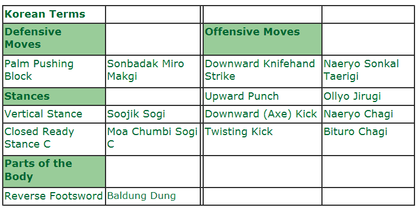Primary Taekwon-Do
Red Belt - 2nd Kup
Practical
Combinations in Line Work – Taken from patterns
3 Step Sparring
One step sparring traditional advanced
One step sparring freestyle (Using middle punch attack, any combo of counters & restraints)
Free Sparring & 2 on 1 Free Sparring
Self-defense, release moves, grasps, holds and take downs
Power test, techniques determined by examiner on the day
All Patterns

Theory
1.How many moves in Hwa-Rang? – 29
2.Meaning of Hwa-Rang? – Hwa-Rang is named after the Hwa-Rang youth group which originated in the Silla Dynasty about 600 A.D. This group eventually became the driving force for the unification of the three kingdoms of Korea . The 29 movements refer to the 29th Infantry Division, where Taekwon-Do developed into maturity.”
3.What is the 1st move of Hwa-Rang. Both in Korean & English and explain its purpose? – Palm Pushing Block – Sonbadak Miro Makgi
4.Demo & what is the Korean for downward Knifehand strike? – Naeryo Sonkal Taerigi
5.What is the Korean for the upward punch in Hwa-Rang & explain its purpose? – Ollyo Jirugi
6.What is the Korean for “X” fist pressing block? – Kyocha Joomuk Noollo makgi
7.What is the Korean for sliding & explain it? – Mikulgi – It is an effective technique for covering a long distance in one smooth motion.
8.Which 3 patterns have release moves. Demo & explain the difference between them? – Do-san, Joong-Gun and Hwa-Rang.
9.Name 8 different blocks. Both in Korean & English? – Najunde Bakat Palmok makgi, Kaunde An palmok makgi, Najunde Sonkal makgi, Chookyo makgi, Sang Palmok makgi, Sonkal Daebi makgi, Hechyo makgi, Dollymio makgi, Golcho makgi, Sang Sonkal makgi, Doo Palmok makgi, Digutcha makgi, Noolyo makgi, Sonkal Dung makgi, Kyocha Chookyo makgi, Kyocha Noollo makgi, miro makgi and San makgi
10.Name 7 different kicks. Both in Korean & English? – Apcha busigi (front snap kick), Yop chajirugi (side piercing kick), Dollyo chagi (turning kick), Dwit chajirugi (back piercing kick), Bandae Dollyo chagi (reverse turning kick), Naeryo chagi (downward or axe kick), Noollo chagi (pressing kick), Yonsok chagi (consecutive kick), Bituro chagi (twisting kick)
11.Name 7 different stances. Both in Korean & English? – Gunnon (Walking), Annun (Sitting), Niunja(L stance), Narani (Parrallel), Charyot (Attention), Gojong (fixed), Moa (closed), Goburyo (bending), Kyocha ( “X” ), Nachuo (Low), Dwitbal (rear foot), Soojik (vertical), Sogi (Stance).
12.Name 8 different hand parts. Both in Korean & English? – Fore fist (Ap Joomuk), Back fist (Dung Joomuk), Side fist (Yop Joomuk), Knifehand (Sonkal), Reverse Knifehand (Sonkal Dung), Finger tips (Sonkut), Arc Hand (Bandal Son), Elbow (Palkup), Palm (Sonbadak), Open fist/palm heel (Pyun Joomuk)
13.Name 5 different foot parts. Both in Korean & English? – Ball of the foot (Apkumchi), Foot sword (Balkal), Instep (Baldung), Back Heel (Dwichook), Toes (Balkut), Back sole (Dwitkumchi), Reverse Foot sword (Balkal Dung) Knee (Moorup).
14.When performing L-stance & punch in Hwa-Rang. Is it obverse or reverse & why? – Obverse (Baro), as rear leg is the primary leg and the rear hand used.
15.What is the ready position in Hwa-Rang. Both in Korean & English? - Closed ready stance “C” – Moa jumbi sogi “C” (Hands 10cm from the lower abdomen)
16.Name the 4 parts of your forearm. Both in English and Korean? – Bakat (outer) An (inner) Dung (back) Mit Palmok (forearm belly)
17.Why do we perform patterns? – To practice both offensive & defensive techniques against imaginary opponent, or opponents. To build strength, speed, balance and timing with your body.
18.Why do we learn the meanings of patterns? – To gain inspiration and remember the history of those who came before us.
19.What is Twisting kick in Korean & what part of the foot is used? – Bituro Chagi – Ball of the foot (Apkumchi).
20.Name 3 different fingertip thrusts. Both in Korean & English? – Upset Finger tip thrust – Dwijibun Sonkut Tulgi, Flat finger tip thrust – Opun Sonkut Tulgi, Straight finger tip thrust Sun Sonkut Tulgi.
21.What does the colour Black signify, What is meant by impervious to darkness & fear? – Black is the opposite of white, therefore signifying maturity and proficiency in Taekwon-Do. It also indicates the wearer’s imperviousness to darkness and fear.
22.What is the Korean for Vertical stance & explain it? – Soojik Sogi – body weight 60/40, rear leg is primary as most weight is on it, both feet pointed 15 degrees inward, length of 1 shoulder width between big toes.
23.How have you supported your club and organization? – Think of all the things you have done over the years.
24.Why do we do free sparring and 2 on 1 sparring? – To learn how to block, evade and counter against more than one attacker.
25.What is the difference between ITF & WTF Taekwon-do? – ITF is the Traditional Taekwon-Do based on the teachings of General Choi Hong Hi 9th Dan, the founder of Taekwon-Do. In sparring ITF TKD allows punching to the head. The Olympic style of WTF TKD is a sport that shares the name (although written differently). During Olympic WTF TKD competitions no punching to the head is allowed. WTF TKD do perform Patterns (poomse) but these are not based on the original 24 patterns designed by the founder of Taekwon-Do, Gen Choi Hong Hi. As WTF TKD is a sport the onus is on beating someone, that someone being an opponent, the original International Taekwon-Do Federations (ITF) Taekwon-Do is based on self development and improvement of one’s self.
26.One question from previous Gradings! – Remember and know your previous Theory